|
TennisOne Lessons Channeling More Energy Into Your Serve by Doug King Why is it that the best servers seem to look so natural? It is as though every nuance of movement has purpose and direction, and is coordinated to a unified end - that is, to make the ball go to a specific spot. The answer is efficiency. The pros have an awareness of energy - how to produce it, how to store it, and how to transfer it to the ball and beyond. In this article I will explain my thoughts on the mechanics of energy transfer using some simple techniques that anyone can understand and apply to their tennis game. In the process I will argue against some of the common theories of the serve that are based on a whip or pendulum motion or that emphasize a wrist snap.
Living in the wine country I have become exposed to the art of wine tasting. One of the more impressive skills of a proficient wine drinker is the ability to “swirl” the wine. This “opens” the wine, releasing its full array of flavors. A good wine geek can snatch a glass and with a deft swish produce a tight eddy of vintage cabernet that has all the action of a Randy Johnson fastball. The wine rises in the narrowing glass, increasing in speed while the tapered bowl also concentrates the aromas, producing a more intense “nose.” It occurred to me, while practicing my wine tasting technique (perhaps after a little too much practice), that in a tennis stroke energy flows through the body in much the same manner as the wine in the glass. I could see the wine climbing the sides of the glass and naturally tightening it’s coil as it rose, all controlled out of subtle directions from my hand. I visualized the serve, specifically, as I have always seen the serve as a “funneling” motion. I began to imagine how the wine might be tossed out of the glass and onto another object. This association of the wine as energy made it possible to clearly conceptualize what had been up to then a rather ambiguous proposition (the notion of energy flow) for me. All of a sudden “energy” took on a physical form that I could see and feel. It became a real thing. I could watch it and study how it reacted to various manipulations. I considered the body as a vessel that was as much responsible for containing energy as producing it and releasing it. I saw how the “shape” of the swing was critical in holding in the energy that was developed. I thought about my own tennis game and my serve in particular. I realized how my attempts to add power on the serve was doing just the opposite - that is, creating escape opportunities for the energy that I was able to generate. I decided to take this hypothesis onto the court for further examination. With a half full wine glass, I set out to throw the wine from the glass with the object of having all of the wine hit a desired target with the least amount of disintegration of a continuous stream, that is spray off target. My goal was to have the wine move in a “clump” and have it hit a single point in a single moment. This to me was what I considered to be the most efficient transfer of energy. The Energy Spiral - Extension and Rotation After some practice I was able to achieve the desired result. What I discovered was that the motion used to accomplish this was exactly what I see used by the best servers in their service motion.
First of all a traditional wrist “snap” was useless. All it did was spray the wine everywhere. An arcing swing was even worse as most of the wine didn’t even leave the glass. A purely straight thrust toward the target was better but still sprayed. If I utilized a straighter extension towards the target accompanied with a carefully produced rotation I got the most accuracy. This rotation worked best when it was controlled mostly out of the shoulder but improved if I made subtle contributions from the whole right side of the body. I also found that timing was a critical issue. Adding speed to the equation was a tricky proposition. If I put the speed in too suddenly the wine would get pushed against the bottom of the glass and separate causing a release in more of a broken stream rather that a solid mass. If I went too slowly or hesitated the wine would lose it’s momentum and not leave the glass but simply spill out of the glass. I found myself dealing with the same exact issues and feeling the same exact motion that was required in serving. The great thing was that I could actually see how the energy was being delivered. It provided some very informative feedback that has helped me to acquire a new understanding of the mechanics of power. The Energy Cycle If, in fact, energy is moved through the body like the fluid in a glass, then we can identify three basic phases of the energy cycle; one is the generation of energy ("the birth"), two is the transmission of the energy (“raising” energy), and three, the transfer or release of energy ("letting go"). Fundamental to the generation phase is the creation of the "energy reservoir." Key to the transmission phase is containment and concentration of energy in the “Main Channel.” Most important to the transfer phase are the “Rules of Engagement.” These principles and the energy cycle apply for all strokes but we will study them in particular detail with regard to the serve.
The generation of power starts at the very first moment of preparation with what we could refer to as "collecting" one's self. This is the start of the formation of what I call the "Energy Ball." It is synonymous to what we generally refer to as our "body." It is also the essence of balance, of good movement, and coordination. This "body" is fluid by design and practice and it represents the fundamental source of efficient power in sport. It's life-force is the breath and it's origin is the gut. The transmission of power begins with a dip and swirl of the hips. The Energy Ball is shifted up the torso and through the arm following as close as possible to the "Main Channel." This is a track that aligns to the spine and starts at the lowest point of the racquet tip in the back scratching position and goes up to the ball at contact. Just as important as the generation of the Energy Ball is the “containment” of the energy as it is rolled up the channel. This is done by maintaining rhythm and keeping the racquet and the body properly aligned to the main channel. Rotation is another key element to proper energy shifting and containment. When the energy moves, it is done through a series of coils and uncoils that both capture the energy and at the same time shift it and accelerate it into ever tightening swirls. The racquet and arm movements are actually helping to hold in the energy through most of the serving action. They help form the “glass” that holds in and directs the swirl of energy. Too often the arm is used as an independent appendage whose sole purpose is to whip or snap the racquet at the ball, it's effectiveness associated entirely with racquet and arm speed. This approach leads to improper alignment of the body to the arm. This not only results in a loss of power and control but also serious injury. When the Energy Ball is directed up the Main Channel, it finally reaches the tennis ball at which point the “transfer” of energy occurs. This transfer onto the ball is characterized by the same laws of transfer that apply to all strokes as detailed in my previous article (The Topspin Backhand, How We Lost Our Way, Part 2; under Rules of Engagement) and is based upon an acceleration, and extension and roll through contact that improves connection to the ball and maximizes an efficient transfer of energy while maintaining optimum directional control. This acceleration is called a wrist snap but I will later argue that we never “snap” our wrist on any shot, the serve included. I prefer to imagine that the energy is released out of the arm and hand to the target on the other side of the net and the racquet helps to draw or connect the ball into this flow. Forming the “Energy Ball”
The Energy Ball is formed in the hips. Think of the pelvis as the seat of the wineglass. This area at the very core of the seat of the pelvis is our energy base. With proper breathing and relaxation and good posture we can help to create a reservoir of energy here. When this is accomplished, we are said to be playing with “guts.” (People think that “having guts” is gritting your teeth when in reality it is a deep and full exhale.) The legs bend and the hips swirl to tap into the energy reservoir and begin forming and putting into motion the Energy Ball. Every top server begins with a hip rotation. Many of the top servers (Sampras, Roddick, and McEnroe) start with a slight forward bend, which tends to accentuate this hip roll. The shaping and initiating of the Energy Ball is done through a motion similar to the Hula-Hoop shimmy. Once this Energy Ball is put into motion the next stage is to direct it up through the Main Channel and prepare to complete the transfer onto and through the ball. The Main Channel The key to good energy management is an understanding of the “Main Channel." This is a track that follows the direction of the spine and goes from the lowest point of the drop the racquet head head in the backscratching position and up to the ball at contact. Imagine a pole attached to your back that runs along the right side of the body, starting from the base of the spine and continuing straight up passing the back of the right ear. This is a reference line for proper alignment between the body, the racquet, and the ball.
In order for the racquet to keep proper alignment through the stroke, imagine you are rolling the Energy Ball up this Main Channel and smoothly rotating it on the channel as you go. From the base of the pole the Energy Ball is drawn up on the outside edge of the channel. This will keep the edge of the racquet towards the net as the arm is lifted (palm facing down). Then just prior to contact, the Energy Ball is rotated back towards the inside of the channel (palm facing the net). How far back towards the inside this is rotated depends on the placement of the serve. For more direction left there is less rotation back, for placement right more rotation back. A perfect example of how this works is to imagine a quiver of arrows slung down your back, resting at an angle and position just like the main channel. Imagine lifting the arrow out of the quiver. The hand grabs the arrow and the shoulder lifts to start the process. The elbow extends and the shoulder continues to lift. When the arrow is completely out of the quiver the arrow will tend to shoot up very naturally as the tension that is built up in the arm by lifting it out of the quiver is released. The best servers have the longest quivers. That is, they stay on the Main Channel longer and therefore create more flex, rotation, and stored energy in the forearm. This creates an extremely compact position with a strong leverage potential. By keeping the quiver pointing at the ball it also keeps the body in proper alignment to support the wrist at contact. It is critical to good energy transfer to differentiate between “swinging” the arm versus aligning the arm to properly accept and store energy. The Transfer When the racquet has directed the energy up to the ball the final stage is the transfer onto and through the ball. The contact of the ball on the serve follows the same principles of contact as any other stroke. These principles can be reviewed in more detail in my previous article, The Topspin Backhand, How we Lost Our Way, Part 2 and The Rules of Engagement.
In summary we come into the ball smoothly from an angle and accelerate through the ball, turning and pushing in a properly timed acceleration to maximize length of time with the ball. This is the means of executing the most efficient transfer of energy. The object is twofold; one, to create alignment of the racquet to the ball and the target and two, to produce an efficient transfer of energy from the body to the ball. This is done through managing the natural spring like qualities of the contact that include the compression of the ball and the recoil of the racquet and the strings. The wrist on the serve is not simply snapping to produce more speed in the racquet but instead the contact is taking into account all of the forces that are available and utilizing them in an efficient system. These forces are linear (the body thrust along the main channel), rotational (for increasing and containing energy on the main channel and to distribute energy on a broader surface and maximize length of time on the ball), and rhythmic (acceleration to maximize length of time on the ball and maximize the spring nature of contact). When these actions are executed properly the result is an efficient use of the body and increased coordination.
When the racquet is used as part of the actual whip chain or the racquet head receives the momentum of the swing (a centrifugal swing) the result is usually a longer, less manageable, arcing swing and/or an unreliable racquet position at contact. This will lead to a breakdown in timing and a loss of control of power. The wrist is not used as much to increase speed through the stroke but rather to increase control of the racquet in terms of alignment and energy transfer by "absorbing" the ball into the energy flow. The wrist may be called on to assist in the flow of energy on a stroke like the serve prior to contact, but when it comes to the actual contact on the ball the primary role is to align and “connect” to the ball and achieve transfer. Never does the racquet “swing” the arm. This usually pulls the arm out of the hit robbing the stroke of the potential power of the thrust from the body into the ball. Never is the ball contacted with the arm at full extension and at highest swing speed. All shots are produced by “catching” the ball in pockets of flex and then accelerating through the ball through extension and rotation. On every stroke, even on the serve, you will always see a speeding up of the action after contact. It doesn’t matter how fast the swing is coming in - more speed and extension in the hitting side should occur after the contact as opposed to full speed and extension at contact. More speed coming in will definitely add more power but acceleration is still needed to achieve proper connection to the ball which results in more control and a more efficient transfer of power. The momentum of the stroke should continue lifting the body up into the contact even after the ball has left the strings. When racquet speed and reaching up for the ball is overemphasized to the detriment of body alignment and focus on the ball, the result is more off center hits and a loss of power commonly referred to as slapping at the ball, “arming” the ball, or “overswinging.” When there isn’t sufficient speed generated, the result is “pushing” or “muscling” the ball.
The action of the wrist is another point of contention. I believe the role of the wrist is misunderstood in the service motion. The arm should be kept very loose so that it can flex and extend but excessive wrist action can cause a tremendous loss of control. In fact, the Continental grip is prescribed because it actually takes most of the wrist out of the serve and puts much more emphasis on flex and extension and rotation of the arm (pronation) instead of wrist whip. This is why people have such a difficult time learning the Continental grip on the serve. It doesn't allow one to slap the wrist at the ball and forces the use of the body instead. The wrist never “snaps” the tip towards the net but the forearm delivers a “windshield wiper” sweep on the ball exactly like the modern forehand. This, again, is part of the proper transfer of energy described in the Rules of Engagement. Remember, the primary role of the racquet is to align to the ball and connect the ball to the flow of energy out of the body and arm. I would argue that the looseness in the wrist is to "absorb" the ball and should be maintained through contact as much as possible as opposed to trying to snap the loose wrist. Principles of Containment I believe the main advantage to this type of system is the sense of structure that it provides. This structure is designed to produce an alignment between the racquet, the body, and the ball that results in a more efficient utilization of energy. The body and arm work together to produce a support system of energy production and controlled transfer. Simply trying to get the arm to whip or the wrist to snap leaves far too many possibilities for alignment breakdowns and timing breakdowns resulting in off center contacts and poor control. Putting momentum in the racquet head is a very risky proposition. It tends to force the body to tighten to resist the centrifugal force at the end. Unwanted tension is the single most disruptive condition in efficient stroking.
The body doesn't swing the racquet and the racquet doesn't swing the body. Instead the arm and the body are connected and work together to generate, contain, and transfer energy from the hips and torso (core), onto the ball and out to the target. They do this through the rhythmic coordination of flex and extension, coil and uncoil, and it involves a series of lags and surges, movements and counter movements. The arm is not swung but rhythmically brought into position to form a structure that channels energy from the body and out to an external target. As the arm is eventually brought into the correct position to accept the energy transfer, this fluid energy body is “poured” into the arm. This makes the arm feel full and heavy and works to extend the arm at the same time. The racquet is helping to draw the ball into this surge. Structure is critical for repetition and consistency. Repetition comes from having reference. Reference for alignment (following the main channel) and reference for timing (smoothly rolling the Energy Ball). Keys to the System 1. Balanced base:
2. Transfer on the Main Channel
3. Maintain rhythm:
Summation The serve by nature is a weak and timing plagued stroke. The contact is away from our power center (our gut) and it requires great timing and control to manage the transfer of energy up to the ball. The only reason we employ this motion is because of the angle that it affords us , not because it is strong - it is not. The only reason we can hope to master this diabolical stroke is because it is the only time that we have the chance to place the ball exactly where we want it. The important thing to remember is that it is a stroke like every other stroke in the game and it is bound by the same principles that govern all strokes. Develop a sense of balance, a sense of rhythm and an awareness of energy transfer as these are the keys to all stroking success. Try some of these exercises and visualizations and use them to guide your serve to more power and control. Your comments are welcome. Let us know what you think about Doug King's article by emailing us here at TennisOne.
Doug is one of the country's leading tennis teaching innovators. Founder of Acceleration Tennis, a revolutionary teaching system, King is leading the way in reinterpreting the traditional tennis model. For more information on Acceleration Tennis please email Doug King at dking@meadowood.com. |

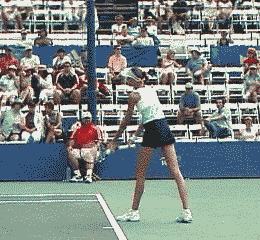
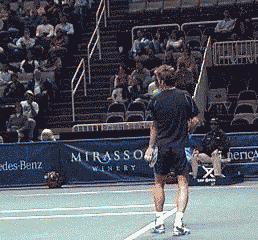
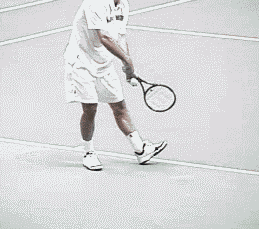
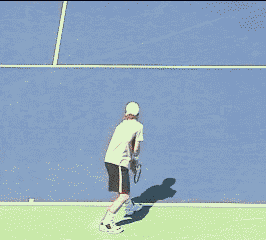
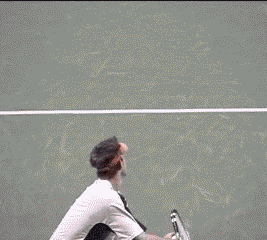
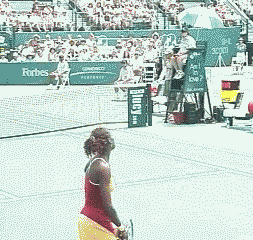
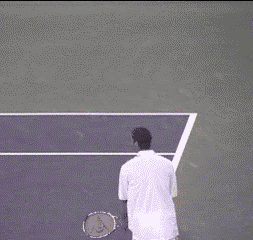
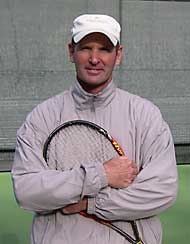
 Doug King studied with legendary tennis coach Tom Stow and was a
former California State Men's Singles Champion
and the former number one men's player of Northern California.
Doug King studied with legendary tennis coach Tom Stow and was a
former California State Men's Singles Champion
and the former number one men's player of Northern California.